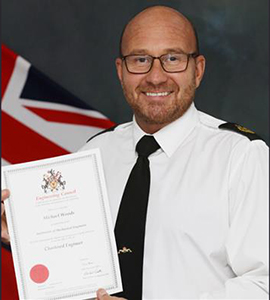
On a wet and miserable July day in 1987, a 16-year-old boy ran inside the Royal Navy’s careers centre in Swansea, Wales, to escape the rain. At the time, the teenager assumed joining the Navy meant being a sailor, just like joining the Army meant becoming a soldier.
Thirty years later, Chief Petty Officer Michael Woods, who specialises in submarine air purification, has become one of the first in his rank to obtain Chartered Engineer status with the Institution of Mechanical Engineers, a milestone he describes as one of his proudest achievements.
That strange twist of fate back in Swansea led Mike, a mechanical engineer, to a life of adventure and learning. A year after joining the Navy, he was on board the HMS Southampton when it collided with a ship ten times its size. Later, he survived a deadly explosion inside the HMS Tireless submarine, which was prowling beneath the Arctic Circle.
He has served on five of the seven Trafalgar class nuclear-powered submarines, has travelled the world - from the North Pole to the Falkland Islands - and has spent the past decade teaching and mentoring young mariners. Part of his mission is to show others that there are many different specialisations within the Navy and that now is an exciting time for aspiring engineers to join the armed forces.
“I keep telling my students that the Navy will keep putting hurdles in front of you,” explains Mike, who is stationed at HMS Sultan in Gosport, Hampshire. “All you have to do is jump over them and move on to the next one. As long as you keep going, the Navy will reward you.”
Mike says that when he joined, he had next to no qualifications and only a murky desire to work with his hands, possibly as an engineer. As he climbed the ranks, he continued to study, earning himself an engineering degree and with it, new opportunities. The armed forces offer simplified routes to professional registration with the Institution and Mike was eligible to apply to register as an Incorporated Engineer. He then pushed on, applying for and securing Chartered Engineer status, which is normally obtained by commissioned officers of higher ranks.
“I always say, ‘there is nothing wrong with being professional’,” says Mike. “There is nothing wrong with being the best version of yourself you can possibly be.”
For him, reaching the Chartered Engineer status means the confidence to feel like an equal when sitting around a table with senior engineers and scientists. It’s his private way to test the level at which he is operating, as he deals with complex machines that provide oxygen to submarine crews, who can spend up to three months underwater. Mike teaches junior mechanics to run the machines and senior engineers to build or maintain them. Without his machines, Mike likes to say, a submarine may as well be a ship.
Following the 2007 HMS Tireless explosion, in which two of Mike’s colleagues lost their lives, he developed a module in oxygen safety, which he teaches.
“Everything is evolving all the time,” he says. “It’s all about continual progressive development, right the way through. Gone are the days where you get your qualification and that’s you.”
For him, engineering is now all about passing on knowledge and preparing the next generation. To the young engineers starting their careers, he says it’s important to remember how many different fields there are to explore and pursue.
“Engineering is definitely available to the masses,” he says. “The Navy is currently growing for the first time in many, many years. There are new ships and submarines on the horizon and we’re recruiting. There are really great opportunities… probably better than at any time in the past.”
A few years ago, one of Mike’s two daughters got him hooked on running. One of his favourite routes was a parkrun in San Francisco, racing towards the Golden Gate Bridge, with sweeping views of the Alcatraz island. But looking back at Mike’s life journey, it’s not a weekend dash that comes to mind, no matter how scenic, but an endurance marathon, which began by chance and is far from over.
“I’ve had some bad days at sea,” Mike says. “But on the whole, I have some really, really special memories serving in the Navy.”
What’s next? Mike has set his periscope on becoming an Institution Fellow.